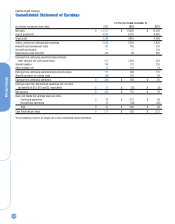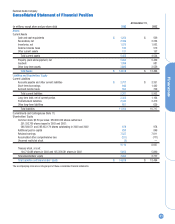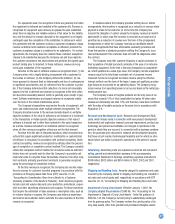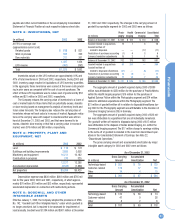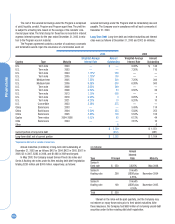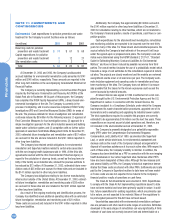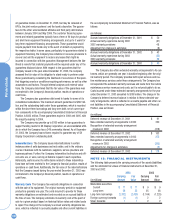Kodak 2003 Annual Report Download - page 50
Download and view the complete annual report
Please find page 50 of the 2003 Kodak annual report below. You can navigate through the pages in the report by either clicking on the pages listed below, or by using the keyword search tool below to find specific information within the annual report.
Financials
50
to allocate resources and in assessing performance. For 2003, the
Company has three reportable segments (Photography, Health Imaging
and Commercial Imaging) and All Other. On August 21, 2003, the Company
announced an organizational realignment, effective January 1, 2004, that
will change the current reportable segment structure. See Note 23,
“Segment Information,” for a discussion of this change.
Recently Issued Accounting Standards In January 2003, the FASB
issued Interpretation No. 46 (FIN 46), “Consolidation of Variable Interest
Entities,” an Interpretation of Accounting Research Bulletin (ARB) No. 51,
“Consolidated Financial Statements.” FIN 46 addresses the consolidation
by business enterprises of variable interest entities (VIEs) either: (1) that
do not have sufficient equity investment at risk to permit the entity to
finance its activities without additional subordinated financial support, or
(2) in which the equity investors lack an essential characteristic of a con-
trolling financial interest. In December 2003, the FASB completed deliber-
ations of proposed modifications to FIN 46 (Revised Interpretations) result-
ing in multiple effective dates based on the nature and creation date of
the VIE. The Revised Interpretations must be applied to all VIEs no later
than the end of the first interim or annual reporting period ending after
March 15, 2004. However, prior to the required application of the Revised
Interpretations, its provisions must be adopted by the end of the first inter-
im or annual reporting period that ends after December 15, 2003 (for the
year ended December 31, 2003 for the Company) for VIEs considered to
be special purpose entities (SPEs). SPEs for this provision include any enti-
ty whose activities are primarily related to securitizations or other forms of
asset-backed financings or single-lessee leasing arrangements. The
Company’s only material SPE as of December 31, 2003 was related to its
equity investment in ESF. Refer to Note 7, “Investments,” for the disclo-
sures required under FIN 46 on ESF. The Company is currently evaluating
the effect that the adoption of FIN 46 for non-SPE VIEs created prior to
February 1, 2003 will have on its financial position, results of operations
and cash flows. The Company did not have a material exposure to loss as
of December 31, 2003 in relation to any VIEs which it had created or
obtained an interest in after January 31, 2003.
In April 2003, the FASB issued SFAS No. 149, “Amendment of
Statement 133 on Derivative Instruments and Hedging Activities.” SFAS
No. 149 amends and clarifies the accounting for derivative instruments,
including certain derivative instruments embedded in other contracts, and
for hedging activities under SFAS No. 133, “Accounting for Derivative
Instruments and Hedging Activities.” SFAS No. 149 is generally effective
for contracts entered into or modified after June 30, 2003 and for hedging
relationships designated after June 30, 2003. The adoption of SFAS No.
149 did not have any impact on the Company’s financial position, results
of operations or cash flows.
In May 2003, the FASB issued SFAS No. 150, “Accounting for Certain
Financial Instruments with Characteristics of Both Liabilities and Equity.”
SFAS No. 150 requires that certain financial instruments, which under pre-
vious guidance were recorded as equity, be recorded as liabilities. The
financial instruments affected include mandatorily redeemable stock, cer-
tain financial instruments that require or may require the issuer to buy
back some of its shares in exchange for cash or other assets, and certain
obligations that can be settled with shares of stock. The Company adopted
SFAS No. 150 on June 1, 2003. The adoption of this statement did not
have any effect on the Company’s financial position, results of operations
or cash flows.
EITF Issue No. 03-05, “Applicability of AICPA Statement of Position
(SOP) 97-2 to Non-Software Deliverables in an Arrangement Containing
More-Than-Incidental Software,” effective September 30, 2003, states
that, only software and software-related elements are in the scope of SOP
97-2. The adoption of EITF No. 03-05 did not have a material impact on
the Company’s financial position, results of operations or cash flows.
In December 2003, the FASB issued a revision of SFAS No. 132,
“Employers’ Disclosures about Pensions and Other Postretirement
Benefits.” SFAS No. 132 requires that companies disclose more informa-
tion about plan assets, benefit obligations, cash flows, benefit costs and
other relevant information. Companies are required to disclose plan assets
by category and a description of investment policies, strategies and target
allocation percentages for these asset categories. Cash flows must include
projections of future benefit payments, and an estimate of contributions to
be made in the next year to fund pension and other postretirement benefit
plans. In addition, companies are required to disclose various elements of
pension and other postretirement benefit costs on a quarterly basis.
Certain provisions of SFAS No. 132 were effective and were implemented
as of and for the year ended December 31, 2003. Certain of the other pro-
visions will be effective for quarterly and annual periods beginning after
December 15, 2003. Refer to Note 17, “Retirement Plans,” for these new
disclosures.
In January 2004, the FASB issued FASB Staff Position (FSP) No.
106-1, “Accounting and Disclosure Requirements Related to the Medicare
Prescription Drug, Improvement and Modernization Act of 2003.” FSP No.
106-1 allows the sponsor of a postretirement health care plan that pro-
vides a prescription drug benefit to make a one-time election to defer
accounting for the effects of the Medicare Prescription Drug, Improvement
and Modernization Act of 2003 (the Act). The Act, which was signed into
law in December 2003, introduces a prescription drug benefit under
Medicare as well as a federal subsidy to sponsors of retiree health care
benefit plans that provide a benefit that is at least actuarially equivalent to
Medicare. The guidance in this FSP is effective for interim or annual finan-
cial statements of fiscal years ending after December 7, 2003. In accor-
dance with FSP No. 106-1, the Company has elected to defer accounting
for the effects of the Act. Refer to Note 18, “Other Postretirement
Benefits,” for disclosures required by FSP No. 106-1.
Reclassifications Certain reclassifications have been made to the prior
periods to conform to the 2003 presentation.
NOTE 2: RECEIVABLES, NET
(in millions) 2003 2002
Trade receivables $ 2,028 $ 1,896
Miscellaneous receivables 361 338
Total (net of allowances of $112 and $137) $ 2,389 $ 2,234
Of the total trade receivable amounts of $2,028 million and $1,896
million as of December 31, 2003 and 2002, respectively, approximately
$528 million and $371 million, respectively, are expected to be settled
through customer deductions in lieu of cash payments. Such deductions
represent rebates owed to the customer and are included in accounts


